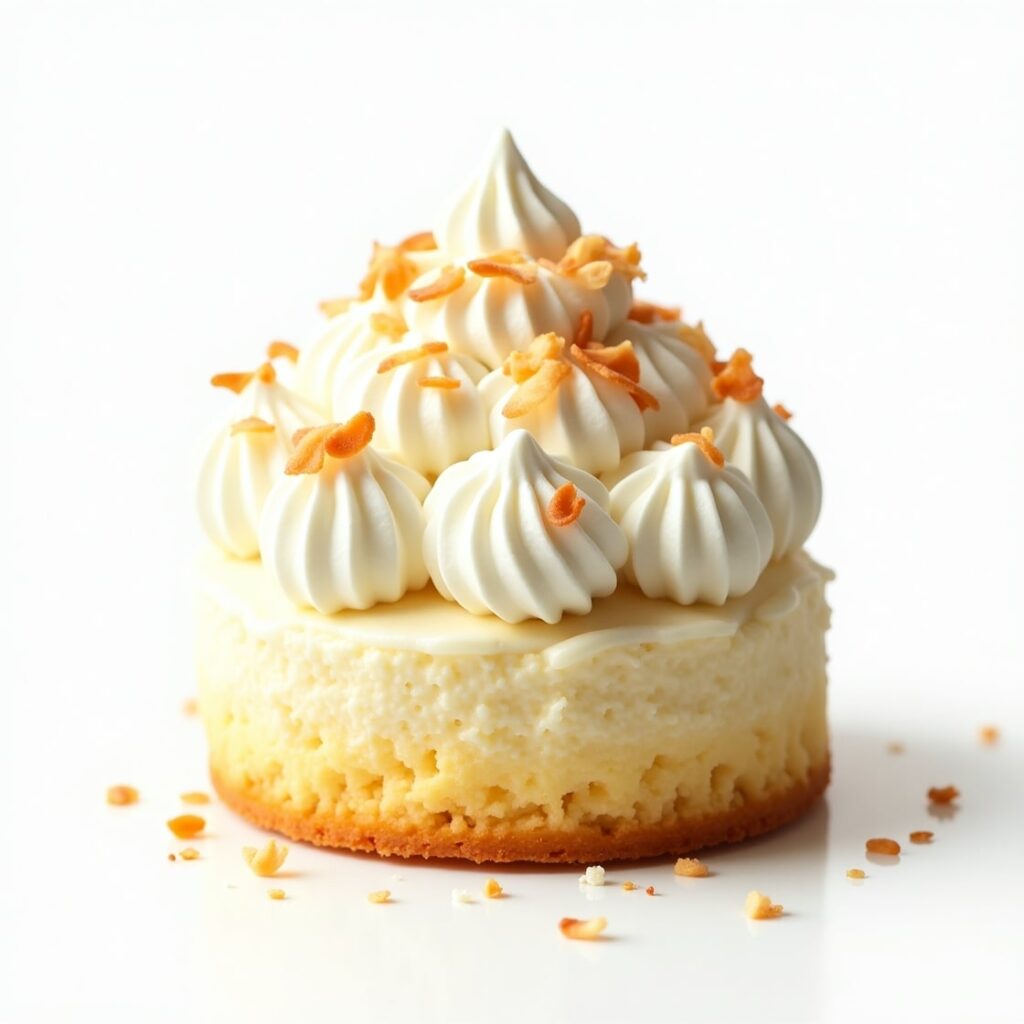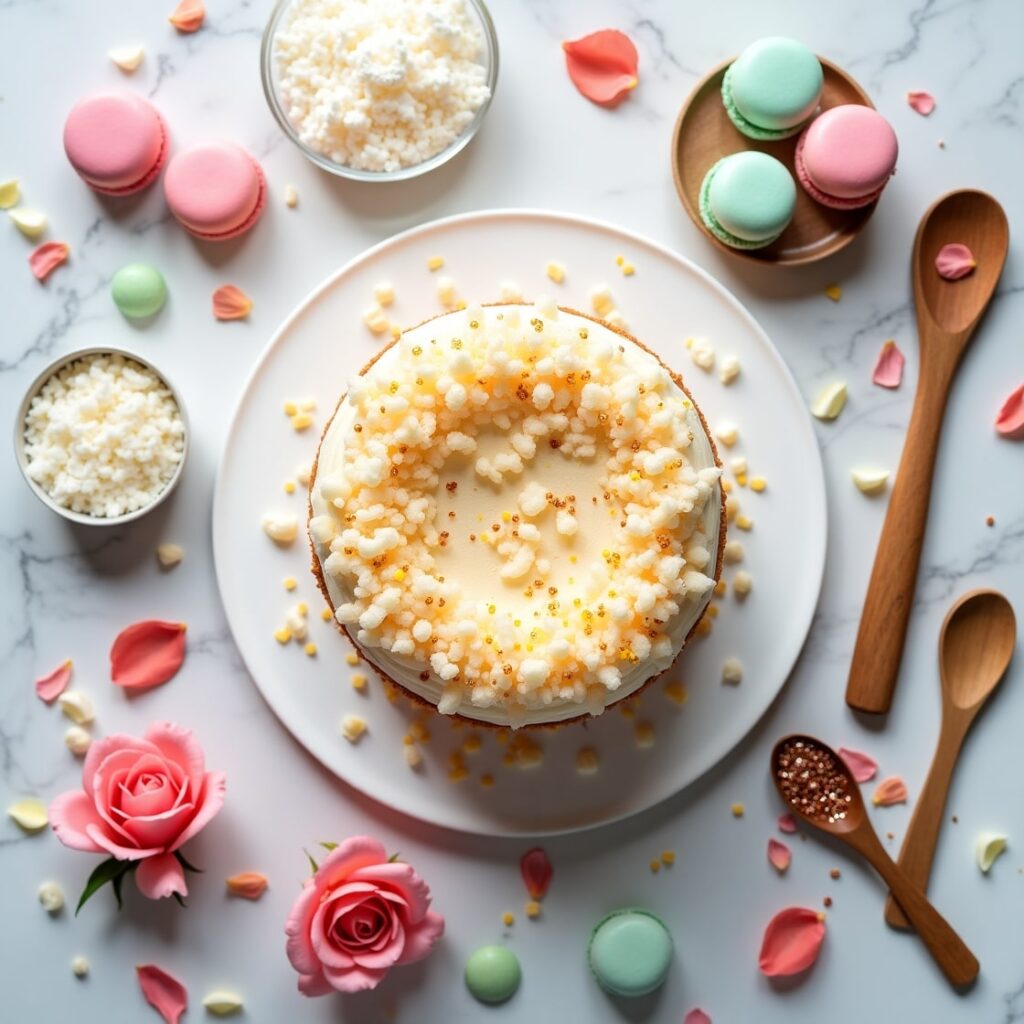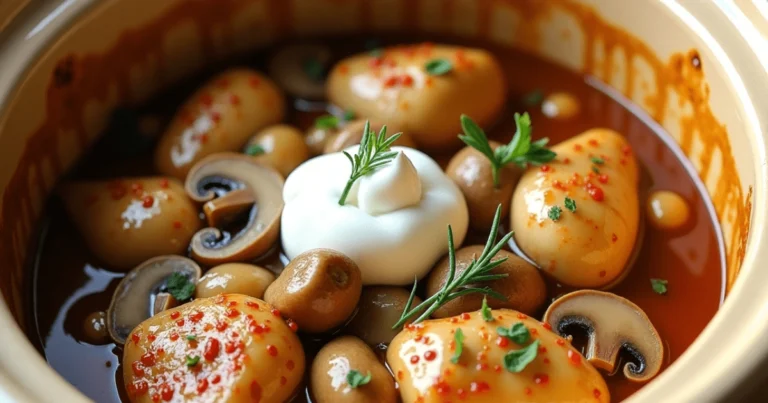Coconut Cloud Cake – The Ultimate Tropical Dessert Experience
Introduction to Coconut Cloud Cake
What Is a Coconut Cloud Cake?
Think of a dessert so soft and dreamy, it practically vanishes the moment it hits your tongue—like tasting a gentle breeze from a tropical island. That’s the kind of experience Coconut Cloud Cake delivers. With its ultra-light, delicate layers of cake, velvety coconut cream filling, and a final flourish of toasted coconut flakes that add just a hint of crunch, every bite feels like sunshine on a plate. It’s the perfect blend of rich and refreshing, making it an ideal choice when you want something sweet without feeling heavy—especially on a warm, lazy afternoon.
Unlike dense cakes or overly sweet pastries, the Coconut Cloud Cake is known for its airiness—thanks to its meringue-like sponge base or chiffon-style cake layers. It’s often infused with coconut milk or coconut cream, which adds richness without overwhelming the palate. Topped with whipped coconut frosting and a shower of coconut flakes, it’s no wonder why people fall in love at first bite.

Why It’s Gaining Popularity
With the rising trend of tropical-inspired cuisine and health-forward baking, Coconut Cloud Cake is becoming a must-have in many bakeries and home kitchens. It is a hit on social media platforms, especially on Instagram and TikTok, where bakers showcase its delicate texture and photogenic layers. Plus, with coconut being hailed as a superfood, more people are turning to recipes that incorporate its natural flavor and benefits.
People are also moving towards lighter desserts that do not leave them feeling overly full, especially in summer months. Coconut Cloud Cake checks all the boxes—it’s more than just a pleasant treat; It is a cool, refreshing escape with every bite. From family gatherings to elegant garden parties, this cake is becoming a go-to crowd-pleaser.
The Origin and Inspiration Behind the Coconut Cloud Cake
A Tropical Take on Classic Desserts
The Coconut Cloud Cake is believed to have evolved from traditional sponge cakes and angel food cakes, with a tropical twist. It borrows the light-as-air structure from classic European pastries and fuses it with ingredients more common in Southeast Asian and Caribbean cuisines. The result? A dessert that bridges continents and culinary traditions.
It is inspired by the essence of sunshine, sandy beaches, and the island lifestyle. Picture sipping a piña colada under a beach umbrella, with coconut palms gently swaying overhead—that’s the vibe this cake brings to the table. Bakers around the world have reimagined the classic sponge cake by infusing it with coconut milk, layering it with coconut cream, and topping it off with flakes that resemble tropical snow.
In a way, it’s not just a cake—it’s a vacation in every slice.
Coconut in Global Cuisine
Coconut has always played a starring role in the kitchens of tropical regions. From curries in Thailand and India to desserts in the Caribbean and Brazil, its versatility makes it a staple ingredient. In baking, coconut offers a unique ability to add moisture and a subtle nutty flavor that pairs wonderfully with fruits, chocolates, and spices.
In Hawaiian and Polynesian culture, coconut is often used in desserts such as Hausa and coconut puddings, while in the Philippines, bubo (young coconut) is featured in pies and cakes. The Coconut Cloud Cake draws inspiration from all these traditional delicacies and modernizes them for a global audience.

Ingredients That Make the Cake Heavenly
Key Ingredients and Their Role
Let’s dive into what makes this cake truly stand out. The key ingredients that bring it to life are:
- Coconut Milk or Cream – Adds richness and that signature tropical flavor.
- Cake flour – Gives the cake its light, tender texture, making each bite feel as soft and airy as a cloud.
- Egg Whites – Whipped to stiff peaks, they provide the airy texture.
- Sugar – Balances the natural sweetness of the coconut without overwhelming.
- Butter or Oil – Adds moisture and enhances flavor.
- Toasted Coconut Flakes – For texture and a finishing touch that looks gorgeous.
- Baking Powder – Helps the cake rise without making it dense.
Each ingredient plays a specific role. The coconut milk gives it that unmistakable island aroma and flavor. Egg whites, when whipped properly, trap air and make the cake super soft. The key here is not to overmix and to fold gently to keep the air bubbles intact.
Vegan and Gluten-Free Alternatives
Don’t worry if you’re avoiding animal products or gluten—Coconut Cloud Cake can easily be modified to fit your dietary needs:
- Use aquafaba (chickpea brine) instead of egg whites for the fluff.
- Almond or oat flour can be blended with a bit of cornstarch to mimic cake flour.
- Coconut oil replaces butter beautifully.
- Plant-based coconut whipped topping is now widely available in most stores.
These substitutions don’t just help you avoid allergens or animal products—they can also enhance the coconut flavor and create a cake that’s just as delicious (if not more!).
Table of Contents
Step-by-Step Guide to Making Coconut Cloud Cake
Prepping the Ingredients
Before you even turn on the oven, preparation is key. Gather all your ingredients and allow them to come to room temperature. Cold eggs won’t whip properly, and melted butter needs time to settle. Here’s what to do:
- Sift the dry ingredients (flour, baking powder, a pinch of salt).
- Separate your eggs carefully—no yolk in the whites!
- Beat the egg whites until they become firm and shiny, holding their shape well.
- Slowly and softly mix in the flour and coconut milk mixture.
- Heat your oven to the required temperature and line your cake pans with parchment paper, then lightly grease them.
If you’re using toasted coconut flakes for garnish, go ahead and toast them lightly in a pan or oven—just until golden brown.
Baking the Fluffy Layers
Once your batter is ready, it’s time to bake! Divide it evenly between your pans and smooth out the tops with a spatula. Bake at 325°F (165°C) for 25–30 minutes or until a toothpick comes out clean.
The trick here is low and slow—you don’t want a high temperature that will brown the outside too quickly and leave the inside undercooked. This cake needs to rise gently, like a soufflé. Once baked, let the layers cool completely before attempting to frost or stack.
You’ll notice that the cakes are incredibly light and airy, almost like sponges. That’s what the whipped egg whites are responsible for. Be careful while handling them—they’re delicate!







